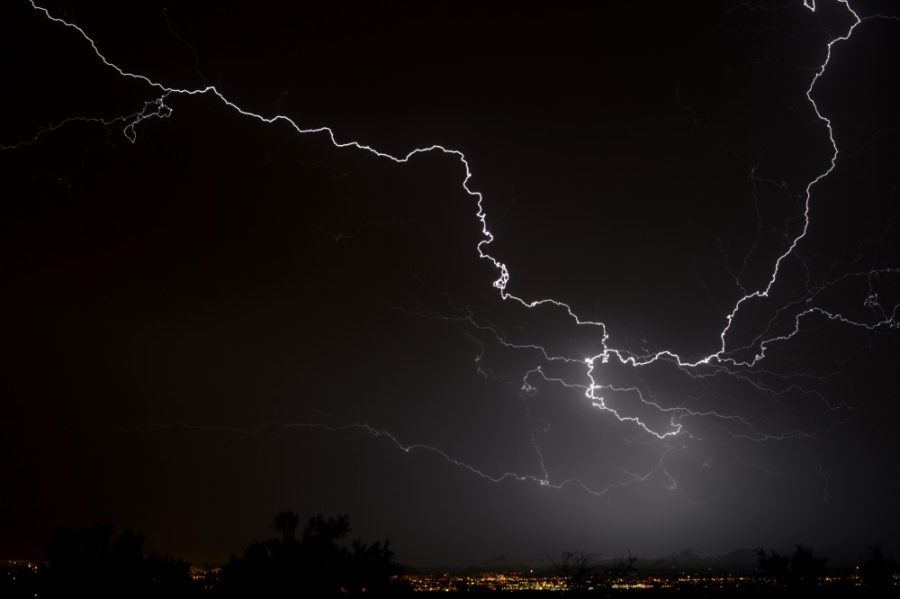In September, the amount of carbon dioxide in the atmosphere stayed over 400 parts per million for the first time in thousands of years—a level more than 100 ppm over the atmosphere’s natural variations.
Four hundred ppm had been labeled as a “tipping point” at which the climate would begin an unstoppable slide into hotter temperatures.
Yet Jonathan Overpeck Ph.D., co-director of the Institute of the Environment, said the number is more symbolic than scientific, though it’s still a cause for concern.
“We don’t know if the tipping point was higher or lower than this,” Overpeck said. “There are actually many different tipping points.”
Even though the tipping point is unclear, Overpeck said that the future is not.
“We’re at the point where we’re not going below 400 ppm for thousands of years,” Overpeck said. “This is just the tip of the iceberg.”
Ben Champion, director of the Office of Sustainability, agreed that 400 ppm is more of a rallying cry—a “nice, round number” people can latch on to.
“We as human creatures, as social beings, as homo sapiens, have a tendency to like symbolism,” Champion said.
Champion is more concerned with the way we’re using our carbon budget—the amount of carbon we can burn without pushing the earth above two degrees of warming.
“We’re only now feeling the effects from emissions from decades ago,” Champion said. “We’ve got to bring it back down.”
While the passing of 400 ppm was certainly foreseen, it was not projected to happen so soon. Overpeck said the factor that threw off predictions was the emergence of China.
“It was the super-charging of China people failed to anticipate 25 years ago,” Overpeck said. “We saw that coming, we just didn’t see how fast. However, we also didn’t see how fast China would realize it was a problem.”
China is doing the most out of the big emitters to reduce emissions.
Overpeck said that while it’s sweeping proactivity was good, it’s something the Chinese society and government allows for, unlike America’s.
Champion followed that idea, saying the only way for the UA to become carbon neutral quickly would be to essentially shut campus down.
“Our mission isn’t served if we shut campus down,” Champion said. “What do post-2050 universities need to look like? There’s no model, but it means systematic change, not incremental refinements. We’re not planning for that right now, but my job is to figure out how to get us there.”
The UA may not be planning for sweeping changes, but it’s still a leader in climate research and climate solutions, and has been working to help inform decision makers on human adaptation techniques and the maintenance of natural ecosystems, according to Overpeck.
“We are ground zero for climate change in the U.S.,” Overpeck said. “We have the most urgent reasons to act on climate change.”
Those reasons are increases in severe droughts and storms, insect infestations, tree deaths, the frequency and size of fires and dwindling fresh water resources.
Overpeck sees solar technology as a way to help move Arizona forward—technologically and economically.
“We can solve our problem with technology that will be a really large resource for Arizona in particular,” Overpeck said. “Shifting away from fossil fuel burning will bring jobs to Arizona. It’s not just solving our problems locally—people around the world will be buying the technology.”
Champion has a similar mindset, though he has doubts about the ability of solar technology to provide everything needed, especially on campus.

“Sunk investment in fossil fuels is what’s really stopping us,” Champion said. “Our campus is a test bed for hidden challenges.”
One of those challenges is the inability of solar to produce steam, which many buildings on campus require.
The central plant system UA currently uses provides that steam as a by-product of the electricity, making it a two-for-one deal.
For those reasons, Diego Martinez-Lugo, an environmental studies senior and chair of the Students for Sustainability Energy and Climate Committee, called the issue multifaceted.
“We can’t just look for technological or financial solutions,” Martinez-Lugo said. “We need to look for philosophical and moral solutions as well. There is no silver bullet.”
One way Martinez-Lugo addresses that need is by raising awareness on campus about what climate change really means and looks like.
“I’m not a climate scientist.” Martinez-Lugo said. “I’m just focused on how to translate that science. We need to translate 400 ppm from an abstract to something tangible, so instead of talking about melting ice caps that we never see, we talk about how it will get hotter and drier.”
Champion added a stark visual to Martinez-Lugo’s picture, saying that “we could turn this planet into Venus.”
Even so, Champion, Martinez-Lugo and Overpeck all agreed that hope is the central takeaway.
“We shouldn’t give up, because there are so many other things we can work toward,” Overpeck said.
Follow Marissa Heffernan on Twitter.









